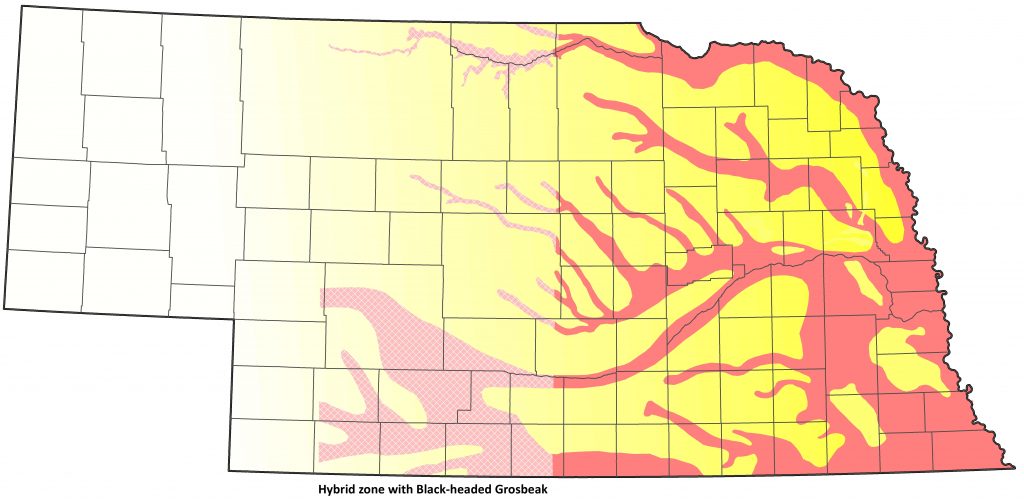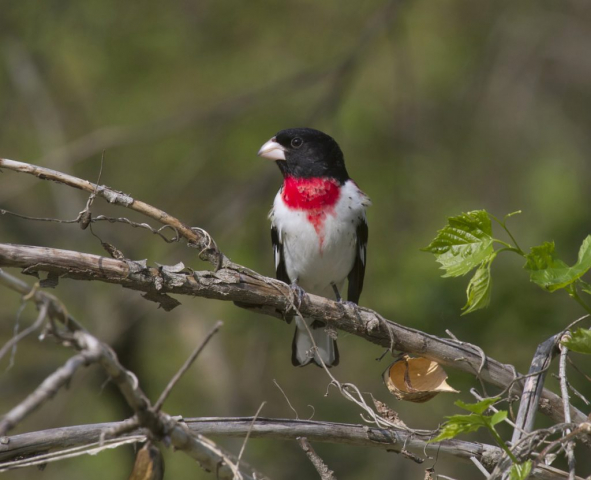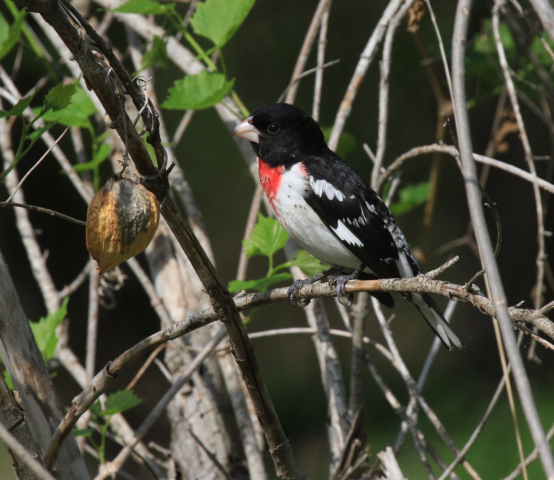Pheucticus ludovicianus
Status: Common regular spring migrant east, fairly common east central, uncommon west central and west. Common regular breeder east, uncommon east central, rare west central. Common regular fall migrant east and east central, rare casual west central and west. Rare casual winter visitor east.
Documentation: Specimen: UNSM ZM12080, 31 May 1895 Lancaster Co.
Taxonomy: No subspecies are recognized (AviList 2025).
This species hybridizes with Black-headed Grosbeak; for a discussion see the Rose-breasted x Black-headed Grosbeak species account.
Spring: Apr 22, 23, 23 <<<>>> summer (east, east central); May 1, 1, 3 <<<>>> Jun 7, 7, 8 (west, west central)
Earlier dates in the east and east central are 20 Apr 2024 Lincoln, Lancaster Co, and 20 Apr 2024 Two Rivers SRA, Douglas Co.
Earlier dates west and west central are 23 Apr 2016 Cherry Co, and 29 Apr 2018 Deuel Co.
A later date west and west central is 14 Jun 1922 Garden Co (Swenk 1931). Later dates west and west-central are of migrants; there are no reports 15 Jun-14 Jul. See Summer.
Migrants generally appear in early May, although early dates are in late Apr. However, one at a Bayard, Morrill Co feeder 22 Apr 2001 had been there about 10 days, and another was early in the west-central in Lincoln Co 1 May 2020. The earliest date for Kansas is 22 Apr (Thompson et al 2011), the same as for Iowa (Kent and Dinsmore 1996).
In the Panhandle it is uncommon, with reports in the period 12 Apr-7 Jun. As far west as Lake Ogallala it can be fairly numerous in spring; 15 were counted 2 May 1997 (Brown et al 1996). The 13 reports in spring 2022 were considered a “good year”.
A study by Jorgensen and Brenner (2024) found that spring arrival dates had advanced by five days from 1938 to 2024.
- High counts: 80 at Fontenelle Forest, Sarpy Co 3 May 2012, 61 in Sarpy Co 11 May 1996, and 59 there 13 May 1995.
Summer: The first known records for Nebraska were sightings by Thomas Say at Engineer Cantonment, Washington Co 1 and 6 May 1830 (Swenk 1931). Bruner et al (1904) stated that Rose-breasted Grosbeak bred in the eastern third of Nebraska, west to about Grand Island; Swenk (1936) showed a zone of overlap with Black-headed Grosbeak approximately from Holt Co south to Webster Co. Rapp et al (1958), while noting that the species bred in the eastern half of Nebraska, stated that “There is evidence that this bird is moving westward through the major river valleys.” Recent information does not support any further significant westward spread, however. Johnsgard (1979) considered the western extent of the breeding range difficult to discern due to hybridization with Black-headed Grosbeak but noted that Rose-breasted Grosbeak bred west to Holt, Garfield, and Phelps Cos, similar to the western extent of the range of phenotypically pure Rose-breasted Grosbeaks noted by Short (1961). The two breeding bird atlases (Mollhoff 2001, 2016) show minimal change between 1984-1989 and 2006-2011, except perhaps for the western edge of the range in the Loup River drainage, the southwest, and in three Panhandle counties (Box Butte, Sheridan, Scotts Bluff); breeding, however, was confirmed west only to Sherman Co.
Breeding in the Niobrara River Valley currently is limited to the lower portion, west to the Niobrara Valley Preserve area where Keya Paha, Brown, and Rock Cos meet; the meeting point of the breeding ranges of Rose-breasted and Black-headed Grosbeaks occurs there. As recently as the early 1980s, Brogie and Mossman (1983) found Rose-breasted Grosbeak common in the Niobrara Valley Preserve, but only as a spring migrant in May, and “Evidently none stayed to nest.” However, Youngworth (1955) found Rose-breasted Grosbeak breeding in northeast Cherry Co in the 1930s; Swenk (1936) reported a nest with eggs found by W. C. Smith near Long Pine, Brown Co 6 Jun 1898 (Mollhoff 2022). Mollhoff (2016) showed breeding season reports west only to the Niobrara Valley Preserve area, unchanged from 1984-1989 (Mollhoff 2001). One was near Sparks, Keya Paha Co 13 Jun 2021 and two were there 21 Jun 2025. There is a Cherry Co report 16 Jun 1977, and recent Cherry Co reports for Fort Niobrara NWR 28 Jun 2016 and 14 Jul 2016, and Smith Falls SP 24 Jun 2025.
In the western Loup River drainage, it is scarce; it was considered an “uncommon migrant of uncertain status” at NNF Bessey in the early 1990s (Bray 1994). There is no evidence of breeding, but recent reports from the western drainage are 29 Jun 2016 Greeley Co, two at a Burwell feeder, Garfield Co 11 Jun 2011, two in Loup Co 26 Jun 2010, and five reports in Custer Co 20 Jun 2009, 29 Jun 2016, 3 Jul 2016, 14 Jun 2021, and 5 Jun 2023. Mollhoff (2016) showed three breeding season reports 2006-2011 in Custer Co, as in the first atlas period 1984-1989 (Mollhoff 2001). One was reported in Hooker Co late May 1907 (Swenk 1931).
In the North Platte River Valley, there are few reports; this area is well within the range of Black-headed Grosbeak, and reports are likely westerly migrants lingering from spring, such as the male at a Mitchell, Scotts Bluff Co feeder with a Black-headed Grosbeak family 24 Jul 2004. There are, however, about 13 midsummer reports (15 Jun-14 Jul) west to Lincoln Co. It has been present since 2005 in increasing numbers in summer west to cedar canyons of southeast Lincoln Co, eastern Hayes Co and western Frontier Co at Red Willow Reservoir; it probably breeds throughout this area of the southwest (T.J. Walker, personal communication). One was at Benkelman, Dundy Co 18 Jun 2025. Black-headed Grosbeak breeds commonly in this area of the southwest also (Mollhoff 2016).
Brown and Brown (2001) stated that “it presumably breeds in the [Keith Co] area. No nests have been found, but one bird with a brood patch was mist-netted 16 May.” One was at Lake Ogallala, Keith Co 3-10 Jun 2025. The only recent reports west of Keith Co are of one in Gering, Scotts Bluff Co 10 Jul 2013, one in the Wildcat Hills, Scotts Bluff Co 19 Jun 2023, and reports at Crescent Lake NWR, Garden Co 2-13 Jun 2008 and 5 Jun 2010.
Away from the North Platte River Valley in the Panhandle, where Jun-Jul reports are most likely lingering spring migrants or the occasional phenotypically “pure” bird at the west edge of the hybrid zone (Short 1961), there is no evidence of nesting of Rose-breasted Grosbeaks; the few reports are 13 Jun 2009 Chadron SP, Dawes Co, 10-15 Jun 2006 Smith Lake WMA, Sheridan Co, 20 Jun 1998 northeast of Chadron, Dawes Co, 20 Jul 2012 Sowbelly Canyon, Sioux Co, a singing male in Dawes Co 19 Jul 1979 (Rosche 1982), 8 Aug 1992 Dawes Co, and 10 Aug 2014 Wildcat Hills SRA, Scotts Bluff Co.
In the Republican River Valley, it occurs west to the Harlan Co area; Swenk (1936) found it west to Inavale, Webster Co. West of there, Black-headed Grosbeak and hybrids are common.
BBS trend analysis (Sauer et al 2020) shows this species has declined in Nebraska annually by -1.11% (95% C.I.; -2.37, -0.06) 1966-2019 while during the same period the Black-headed Grosbeak has increased by 1.28% (95% C.I.; -0.81, 3.5).
- Breeding phenology:
Nest building: 4 May-24 Jun
Eggs: 13 May- 9 Jul (Mollhoff 2022)
Nestlings: 8 Jun-15 Jul
Fledglings: 24 Jun-18 Jul
Fall: summer <<<>>> Oct 3, 4, 5 (east, east central)
Later dates east and east central are 7 Oct 2018 Lancaster Co, 8 Oct 2015 Douglas Co, 10 Oct 2015 Douglas Co, 11 Oct 2018 Lancaster Co, and 16 Oct 2013 first fall male photo Lancaster Co. See Winter.
Extraordinary were an immature male 18-25 Oct 2012 and a female 26 Oct 2012 at the same Lincoln Co feeder.
Reports are less than annual in fall in the west and west-central; there are only 15 reports, all from 15 Jul-22 Sep.
Departure begins in late Jul-Aug and is completed by early Oct.
Winter:
Rose-breasted Grosbeaks appear occasionally at feeders in late fall and early winter. These reports are of birds apparently attempting to winter: 15-17 Nov 2023 female Lincoln, Lancaster Co, 22 Nov 1973 through mid-Jan 1974 at feeders Douglas-Sarpy Cos (Williams 1974a, 1974b), 1 Dec 2015 basic plumage Lincoln, Lancaster Co, 31 Dec 1980 Boone Co, and 31 Dec 1980 Lancaster Co. One was found on the Lincoln CBC 17 Dec 2011, an apparent first fall male photographed at an Omaha feeder 7-19 Dec 2011, and 6 Jan 2021 photo Doniphan, Hall Co. A male in breeding plumage was well described but briefly seen in Kearney, Buffalo Co 21 Jan 2023.
- High counts: 40 in Sarpy Co 9 Sep 1995, and 18 on MoPac Trail, Lancaster Co 11 Sep 2020.
Images
Abbreviations
BBS: Breeding Bird Survey
CBC: Christmas Bird Count
NNF: Nebraska National Forest
NWR: National Wildlife Refuge
SP: State Park
SRA: State Recreation Area
UNSM: University of Nebraska State Museum
WMA: Wildlife Management Area (state)
Literature Cited
AviList Core Team, 2025. AviList: The Global Avian Checklist, v2025. https://doi.org/10.2173/avilist.v2025.
Bray, T.E. 1994. Habitat utilization by birds in a man-made forest in the Nebraska Sandhills. M.S. thesis, University of Nebraska-Omaha.
Brogie, M.A., and M.J. Mossman. 1983. Spring and summer birds of the Niobrara Valley Preserve, Nebraska: An annotated checklist. NBR 51: 44-51.
Brown, C.R., M.B. Brown, P.A. Johnsgard, J. Kren, and W.C. Scharf. 1996. Birds of the Cedar Point Biological Station area, Keith and Garden Counties, Nebraska: Seasonal occurrence and breeding data. Transactions of the Nebraska Academy of Sciences 23: 91-108.
Brown, C.R., and M.B. Brown. 2001. Birds of the Cedar Point Biological Station. Occasional Papers of the Cedar Point Biological Station, No. 1.
Brown, C.R., M.B. Brown, P.A. Johnsgard, J. Kren, and W.C. Scharf. 1996. Birds of the Cedar Point Biological Station area, Keith and Garden Counties, Nebraska: Seasonal occurrence and breeding data. Transactions of the Nebraska Academy of Sciences 23: 91-108.
Bruner, L., R.H. Wolcott, and M.H. Swenk. 1904. A preliminary review of the birds of Nebraska, with synopses. Klopp and Bartlett, Omaha, Nebraska, USA.
Johnsgard, P.A. 1979. Birds of the Great Plains: breeding species and their distribution. University of Nebraska Press, Lincoln, Nebraska, USA.
Jorgensen, J.G., and S.J. Brenner. 2024. The changing spring migration patterns of selected bird species in Nebraska 1938-2024. Joint Report of the Nongame Bird Program at the Nebraska Game and Parks Commission and Audubon Great Plains, Lincoln, Nebraska, USA.
Kent, T.H., and J.J. Dinsmore. 1996. Birds in Iowa. Publshed by the authors, Iowa City and Ames, Iowa, USA.
Mollhoff, W.J. 2001. The Nebraska Breeding Bird Atlas 1984-1989. Nebraska Ornithologists’ Union Occasional Papers No. 7. Nebraska Game and Parks Commission, Lincoln, Nebraska, USA.
Mollhoff, W.J. 2016. The Second Nebraska Breeding Bird Atlas. Bull. Univ. Nebraska State Museum Vol 29. University of Nebraska State Museum, Lincoln, Nebraska, USA.
Mollhoff, W.J. 2022. Nest records of Nebraska birds. Nebraska Ornithologists’ Union Occasional Paper Number 9.
Rapp, W.F. Jr., J.L.C. Rapp, H.E. Baumgarten, and R.A. Moser. 1958. Revised checklist of Nebraska birds. Occasional Papers 5, Nebraska Ornithologists’ Union, Crete, Nebraska, USA.
Rosche, R.C. 1982. Birds of northwestern Nebraska and southwestern South Dakota, an annotated checklist. Cottonwood Press, Crawford, Nebraska, USA.
Sauer, J.R., W.A. Link and J.E. Hines. 2020. The North American Breeding Bird Survey – Analysis Results 1966-2019. U.S. Geological Survey data release, https://doi.org/10.5066/P96A7675.
Short, L.L., Jr. 1961. Notes on bird distribution in the central Plains. NBR 29: 2-22.
Swenk, M.H. 1931. The Birds of Nebraska: Part One (Family Fringillidae). Unfinished manuscript in the Nebraska Ornithologists’ Union Archives.
Swenk, M.H. 1936. A study of the distribution, migration, and hybridism of the Rose-breasted Grosbeak and Rocky Mountain Black-headed Grosbeak in the Missouri Valley region. NBR 4: 27-40.
Thompson, M.C., C.A. Ely, B. Gress, C. Otte, S.T. Patti, D. Seibel, and E.A. Young. 2011. Birds of Kansas. University Press of Kansas, Lawrence, Kansas, USA.
Williams, F. 1974a. Southern Great Plains Region. American Birds 28: 70-76.
Williams, F. 1974b. Southern Great Plains Region. American Birds 28: 656-660.
Youngworth, W. 1955. Some birds of the Quicourt Valley. NBR 23: 29-34.
Recommended Citation
Silcock, W.R., and J.G. Jorgensen. 2025. Rose-breasted Grosbeak (Pheucticus ludovicianus). In Birds of Nebraska — Online. www.BirdsofNebraska.org
Birds of Nebraska – Online
Updated 3 Sep 2025


